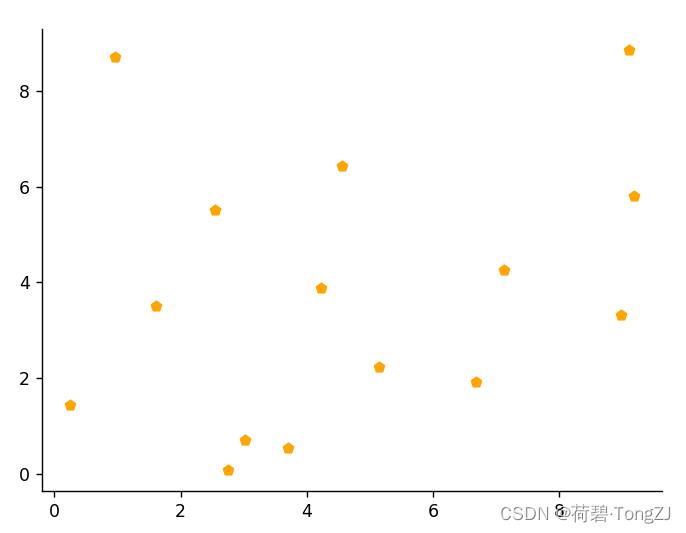Python 遗传算法 Genetic Algorithm
Posted 荷碧·TongZJ
tags:
篇首语:本文由小常识网(cha138.com)小编为大家整理,主要介绍了Python 遗传算法 Genetic Algorithm相关的知识,希望对你有一定的参考价值。
粒子群算法是在 n 维空间内寻找最优解,对于无法映射在 n 维空间内的解集并不能很好的求解
例如旅行商问题,寻找可以遍历 15 个地点的最短路径(当然可以用二进制状态压缩 + 动态规划解决),以 0, 1, ..., 14 表示这些地点,并以 0, 1, ..., 14 的一种排列方式为一个解
当这个问题的解集映射在 15 维空间中时,这个空间中的可行解将非常的稀疏,从而阻碍粒子群的搜索

遗传算法有几个关键词:
- 保优:当种群更新时,不改变最优的几个个体,为交叉提供优质基因并与新个体进行比较
- 天择:根据每个个体的适应度,使用轮盘赌法进行挑选
- 交叉:对天择生成的每个个体,以一定概率与原来的个体进行交叉
- 变异:对天择生成的每个个体,以一定概率进行基因突变
下面是我编写的遗传算法模板,在使用时需要重写 new_unit(群体初始化方法)、cross(两个体交叉方法)、variation(个体变异方法)、fitness_cal(个体适应度计算方法) 函数(后面我将会以旅行商问题进行举例)
其中的 fit 方法为主函数,记群体规模为 n,for 循环体的内容为:
- 对当前的群体进行重叠检测,去除重复的个体
- 计算每个个体的适应度,排序后对适应度前 5% 的个体进行“保优”,得到规模 0.05n 的新群体
- 对原有群体进行天择,选出 0.95n 的个体(可重复),根据概率对每个个体进行交叉、变异操作,加入新群体得到规模 n 的群体
import numpy as np
from tqdm import trange
DTYPE = np.float16
class Genetic_Algorithm:
''' 遗传算法
n_unit: 染色体群体规模
n_gene: 染色体的基因数
well_radio: 最优个体比例
cross_proba: 交叉概率
var_proba: 变异概率'''
def __init__(self,
n_unit: int,
n_gene: int,
well_radio: float = 0.05,
cross_proba: float = 0.4,
var_proba: float = 0.3):
self._n_unit = n_unit
self._n_gene = n_gene
self._well_radio = well_radio
self._cross_proba = cross_proba
self._var_proba = var_proba
self.group = self.new_unit(self._n_unit)
def _random_section(self):
''' 产生随机区间'''
gene_idx = list(range(self._n_gene))
l = np.random.choice(gene_idx)
r = np.random.choice(gene_idx[l:])
return l, r
def new_unit(self, size):
''' 初始化染色体群体
return: [size, n_gene]'''
raise NotImplemented
def cross(self, unit, other):
''' 交叉遗传
return: [n_gene, ]'''
raise NotImplemented
def variation(self, unit):
''' 基因突变
return: [n_gene, ]'''
l, r = self._random_section()
np.random.shuffle(unit[l: r + 1])
return unit
def fitness_cal(self, unit):
''' 适应度函数 (max -> best)'''
raise NotImplemented
def fit(self, epochs: int = 100, prefix='GA_fit'):
unit_idx = list(range(self._n_unit))
pbar = trange(epochs)
# 最优个体数, 随机选取数
n_well = round(self._n_unit * self._well_radio)
n_choose = self._n_unit - n_well
for _ in pbar:
self.group = np.unique(self.group, axis=0)
# 计算每个个体的适应度并排序
fitness = np.array(list(map(self.fitness_cal, self.group)), dtype=DTYPE)
order = np.argsort(fitness)[::-1]
# 保留一定数量的个体
new_group = self.group[order[:n_well]]
pbar.set_description((f'%-10s' + '%-10.4g') % (prefix, fitness[order[0]]))
fitness -= fitness.min()
# 根据适应度, 使用轮盘赌法进行筛选
proba = fitness / fitness.sum()
choose_idx = np.random.choice(unit_idx[:len(self.group)], size=n_choose, p=proba)
# 交叉遗传 / 基因突变
for unit, (pc, pv) in zip(self.group[choose_idx], np.random.random([n_choose, 2])):
if pc <= self._cross_proba:
unit = self.cross(unit, self.group[np.random.choice(unit_idx[:len(self.group)], p=proba)])
if pv <= self._var_proba:
unit = self.variation(unit)
# 拼接新个体
new_group = np.concatenate([new_group, unit[None]])
self.group = new_group
return self.group[0]求解示例
对于 15 个地点的旅行商问题,重写的函数思路如下:
- new_unit:生成 n 个 [0, 1, ..., 14],使用 np.random.shuffle 进行打乱
- fitness_cal:使用实例属性 pos 记录 15 个地点的位置,实例属性 adj 记录这 15 个地点的邻接矩阵;依次遍历个体中的地点叠加距离(越小表示该解越优),并取负值(越大表示该解越优,符合 fit 函数的设计)
- cross:因为旅行商问题中的解在进行交叉时(交换片段),容易出现“重复经过一地点”的情况,故此处不使用交叉
- variation:随机选取区间的左右边界,使用 np.random.shuffle 对该区间的基因进行打乱(已编写在模板中)
if __name__ == '__main__':
import matplotlib.pyplot as plt
class Shortest_Path(Genetic_Algorithm):
def new_unit(self, size):
''' 初始化染色体群体'''
group = []
for _ in range(size):
unit = list(range(self._n_gene))
np.random.shuffle(unit)
group += [unit]
return np.array(group, dtype=np.int32)
def fitness_cal(self, unit):
''' 适应度函数 (max -> best)'''
# 初始化邻接表
if not hasattr(self, 'adj'):
self.pos = np.random.random([self._n_gene, 2]) * 10
self.adj = np.zeros([self._n_gene] * 2, dtype=DTYPE)
for i in range(self._n_gene):
for j in range(i + 1, self._n_gene):
self.adj[i][j] = self.adj[j][i] = \\
np.sqrt(((self.pos[i] - self.pos[j]) ** 2).sum())
# 计算适应度
fitness = 0
for i in range(self._n_gene - 1):
dist = self.adj[unit[i]][unit[i + 1]]
fitness += dist
return - fitness
np.random.seed(0)
ga = Shortest_Path(80, 15, cross_proba=0, var_proba=0.6)
unit = ga.fit(300)
# 绘制最优路径
fig = plt.subplot()
for key in 'right', 'top':
fig.spines[key].set_color('None')
plt.plot(*ga.pos[unit].T, c='deepskyblue')
plt.scatter(*ga.pos.T, marker='p', c='orange')
plt.show()
以上是关于Python 遗传算法 Genetic Algorithm的主要内容,如果未能解决你的问题,请参考以下文章
遗传算法(Genetic Algorithm,GA)实现数据排序,python
遗传算法(Genetic Algorithm,GA)的轮盘赌选择,python